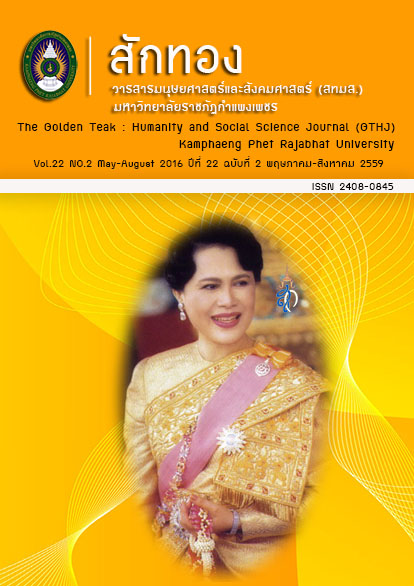รูปแบบการบริหารภาคีเครือข่ายสถานศึกษา ระดับประถมศึกษาที่เป็นเลิศในจังหวัดเชียงใหม่
Main Article Content
Abstract
บทคัดย่อ
การวิจัยเรื่องนี้มีวัตถุประสงค์เพื่อ 1. ศึกษาสภาพและปัญหาการบริหารภาคีเครือข่ายสถานศึกษา ในจังหวัดเชียงใหม่ 2. ศึกษารูปแบบการบริหารภาคีเครือข่ายสถานศึกษา ระดับประถมศึกษา ที่ประสบผลสำเร็จในจังหวัดเชียงใหม่ 3. ตรวจสอบรูปแบบการบริหารภาคีเครือข่ายสถานศึกษา ระดับประถมศึกษาที่เป็นเลิศในจังหวัดเชียงใหม่ ใช้ระเบียบวิธีวิจัยแบบผสม (Mixed Methods) มีวิธีดำเนินการวิจัย 3 ขั้นตอน ขั้นตอนที่ 1การศึกษาสภาพและปัญหาการบริหารภาคีเครือข่ายสถานศึกษา ระดับประถมศึกษา ในจังหวัดเชียงใหม่ ประชากรที่ใช้ศึกษา คือ ภาคีเครือข่ายสถานศึกษาในสังกัดสำนักงานเขตพื้นที่การศึกษาประถมศึกษา จังหวัดเชียงใหม่ จำนวน 6 เขตพื้นที่การศึกษา จำนวน 80 ภาคีเครือข่ายสถานศึกษา เครื่องมือที่ใช้คือ แบบสอบถาม วิเคราะห์ข้อมูลโดยใช้ ค่าความถี่ ร้อยละ และการเรียงลำดับ ขั้นตอนที่ 2 การศึกษารูปแบบการบริหารภาคีเครือข่ายสถานศึกษาที่ประสบผลสำเร็จในจังหวัดเชียงใหม่ แหล่งข้อมูลคือ เครือข่ายสถานศึกษาระดับประถมศึกษา ในสังกัดสำนักงานเขตพื้นที่การศึกษาจังหวัดเชียงใหม่ที่ประสบผลสำเร็จ หรือ มีการบริหารภาคีเครือข่ายฯ ที่ดี ในจังหวัดเชียงใหม่ ผู้ให้ข้อมูล คือ 1) ผู้บริหารการศึกษาหรือผู้เกี่ยวข้องในสำนักงานเขตพื้นที่การศึกษาประถมศึกษา จังหวัดเชียงใหม่ที่มีเครือข่ายสถานศึกษาที่ประสบผลสำเร็จและ 2) คณะกรรมการของภาคีเครือข่ายสถานศึกษา ที่ผ่านเกณฑ์การพิจารณา วิธีการและเครื่องมือที่ใช้ในการเก็บข้อมูล คือ 1) แบบสอบถาม 2) การจัดสัมมนาผู้เชี่ยวชาญ และ 3) ผู้วิจัยวิเคราะห์ข้อมูลโดยการวิเคราะห์แบบอุปนัยและการสังเคราะห์ ขั้นตอนที่ 3 การตรวจสอบรูปแบบการบริหารภาคีเครือข่ายสถานศึกษาระดับประถมศึกษาที่เป็นเลิศ แหล่งข้อมูลที่ใช้ศึกษาเป็นผู้เชี่ยวชาญ จำนวน 15 คน โดยเลือกแบบเจาะจง เครื่องมือที่ใช้ คือ แบบตรวจสอบความเหมาะสม ความเป็นไปได้ และความเป็นประโยชน์ วิเคราะห์ข้อมูลโดยการหาค่าเฉลี่ย และค่าส่วนเบี่ยงเบนมาตรฐาน ผลการวิจัย พบว่า สภาพ การบริหารภาคีเครือข่ายสถานศึกษา ระดับประถมศึกษา จังหวัดเชียงใหม่ มีสภาพการบริหารใน 4 องค์ประกอบเรียงลำดับตามค่าร้อยละเฉลี่ยจากมากที่สุดไปหาน้อยที่สุดดังนี้ ลำดับแรก คือลักษณะของครูและบุคลากรในศูนย์ภาคีเครือข่ายสถานศึกษา ลำดับที่สอง คือ นโยบายการบริหารและการปฏิบัติ ลำดับที่สาม คือ ลักษณะของสภาพแวดล้อม ด้านที่มีค่าร้อยละเฉลี่ยน้อยที่สุด คือ ลักษณะของภาคีเครือข่ายสถานศึกษา ในส่วนของรูปแบบการบริหารภาคีเครือข่ายสถานศึกษา ระดับประถมศึกษาที่เป็นเลิศในจังหวัดเชียงใหม่ มี 5 ส่วน ประกอบด้วย1) องค์ประกอบของรูปแบบฯ 2) แผนภาพแสดงความสัมพันธ์ขององค์ประกอบ 3) รายละเอียดขององค์ประกอบ 4) เงื่อนไขความสำเร็จ และ5) ข้อเสนอแนะในการนำรูปแบบไปใช้ สำหรับผลการตรวจสอบ ความเป็นไปได้ ความเหมาะสม และความเป็นประโยชน์ พบว่าความเป็นไปได้ และความเหมาะสมของรูปแบบฯ ทุกองค์ประกอบและโดยรวม อยู่ในระดับมาก ส่วนลักษณะแวดล้อมภายในองค์การ ภาวะผู้นำ และการตัดสินใจ การปรับตัวขององค์การและการริเริ่มสิ่งใหม่ อยู่ในระดับดีมาก ในขณะที่ความเป็นประโยชน์ของรูปแบบฯ ทุกองค์ประกอบและโดยรวม อยู่ในระดับมากที่สุด ยกเว้นการปรับตัวขององค์การและการริเริ่มสิ่งใหม่ อยู่ในระดับมาก
An Excellent Primary Education School Network ConsortiumAdministration Model in Chiang Mai Province
ABSTRACT
This research was aimed at 1. Reviewing current situation and Problems facing the administration of school network consortium in Chiang Mai Province 2.Examining the successful administration model of such a consortium at the primary education level in Chiang Mai Province and 3. Verifying the administration model considered excellent or outstanding. It adopted the 3-stage mixed research methods, namely, stage 1: Review of current situations and problems; Stage 2 : Examination of successful administration model; and Stage 3: Verification of the excellent or outstanding administration model. Stage 1: relied on quantitative research methodologies. The research population comprised 80 consortia of all school networks in Chiang Mai Province’s 6 educational service areas. Consortium personnel were asked to respond to the prepared questionnaire and the following collected data analyzed using frequency, percentage and ordering. Stage 2: was intended to 1) analytically examine the successful administration model and 2) prepare and draft of the Excellent or outstanding administration model. This stage relied on the qualitative research approach. Sources of data and information were successful or good school networks with informants being 1) educational administrators or those, related of educational service area offices having successful school networks and 2) Members of school network consortia who passed the consideration criteria. They were asked to respond to the set questionnaire followed by an expert’s seminar. Then, the researchers analyzed collected data and information using analytical induction and synthesizing methods. State 3: dealt with 1) the verification of the Excellent or outstanding administration model’s appropriateness, feasibility and utility based on experts’ opinions and 2) the improvement and presentation of the excellent/outstanding administration model. Altogether, 15 purposively sampled experts served as data/information sources. The research instrument was the form designed to verify the model’s appropriateness, feasibility and utility. Data analysis was completed using average and standard deviation. Findings were as follows: As regards the 4 components constituting current administrative situation/conditions the one found to enjoy the highest average was that covering characteristics of teachers and personnel in consortium offices/centers (rated highest/very good) followed by those covering administrative policies and practices (rated high/good); environmental factors (rated also high/good); and characteristics of the consortia themselves (rated high/good but with the lowest average).As for as the excellent administration model was concerned, there were 5 parts, namely, 1) model components 2) illustration showing component relationships 3) component details 4) success conditions and 5) recommendations. Ensuing verification of the model found that its feasibility, every component and as a whole, was at high level, its appropriateness was also at a high level, its internal environment, leadership and decision making, organizational adaptation and new initiatives, were at a very good level, and its utility was at the highest level except organizational adaptation and new initiatives which were at the high level.
Article Details
บทความที่ได้รับการตีพิมพ์เป็นลิขสิทธิ์ของวารสาร สักทอง : วารสารมนุษยศาสตร์และสังคมศาสตร์ สถาบันวิจัยและพัฒนา มหาวิทยาลับราชภัฏกำแพงเพชร
ข้อคิดเห็นใดๆ ที่ปรากฎในวารสารเป็นวรรณกรรมของผู้เขียนโดยเฉพาะ ซึ่งมหาวิทยาลัยราชภัฏกำแพงเพชรและบรรณาธิการไม่จำเป็นต้องเห็นด้วย


